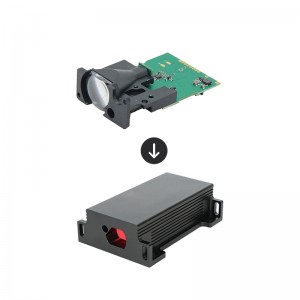Building Survey Field Long Distance Laser Measuring Sensor
A building survey field long distance measuring sensor, often referred to as a laser distance meter module, is a UART laser rangefinder device used for accurately measuring distances in construction, architecture, and surveying. These laser measurement sensor devices are particularly useful for tasks that require precise measurements over long distances, such as:
1. Building Surveys: Measuring the dimensions of buildings, including height, width, and depth.
2. Construction Layouts: Setting out points, lines, and grades for construction projects.
3. Architectural Design: Gathering accurate measurements for design and planning.
4. Real Estate: Measuring property dimensions for appraisals and listings.
5. Facility Management: Conducting maintenance and renovation assessments.
Key Features of Long Distance Laser Measuring Sensors
1. Range: High end laser distance sensor models can measure distances up to several hundred meters (e.g., 100-900m).
2. Accuracy: Typically from ±1 mm to ±0.5 m, depending on the laser measurement sensor model and environmental conditions.
3. Measurement Modes:
Single Distance Measurement: Measures the distance to a single target.
Continuous Measurement: Continuously measures and updates the distance as the target moves.
Area and Volume Calculation: Calculates the area and volume based on multiple distance measurements.
Pythagorean Theorem: Uses indirect measurement techniques to calculate distances that are difficult to measure directly.
4. Connectivity: Bluetooth, RS485, RS232, TTL or USB for data transfer to computers or mobile devices.
5. Targeting: Seakeda long distance measuring sensor models include a red dot or crosshair for easy targeting.
6. Durability: Rugged and weather-resistant designs with IP54 case for outdoor use.
7. Environmental Compensation: Adjusts measurements for temperature and atmospheric conditions.
Email: sales@seakeda.com
WeChat: 86-18302879423
How It Works
1. Laser Emission: The long distance laser measuring sensor device emits a laser beam toward the target.
2. Reflection: The laser beam reflects off the target and returns to the laser measurement sensor.
3. Time-of-Flight Measurement: The distance measurement sensor calculates the time it takes for the laser to travel to the target and back.
4. Distance Calculation: Using the speed of light, the laser distance measurement sensor computes the distance based on the time-of-flight.
5. Data Output: The distance data be stored or transferred to other devices by UART communication interface.
Seakeda Popular Laser Measuring Sensor Models
S95: Known for 1mm high precision and 41*17*7mm mini size U81 module.
M95: Offers IP54 shell and user-friendly RS485 models like M88B.
BA6A: Offers a range of 100m 150m laser distance meter module.
JCJMSS: Provides robust and reliable case like the IP67.
PTF series: Known for military-grade and UAV measuring, including the PTFM-2000 and PTF-LD30X.
Considerations When Choosing a Long Range Laser Distance Sensor
1. Range and Accuracy: Ensure the long distance measuring sensor meets your specific distance and accuracy requirements.
2. Durability: Choose a laser distance measuring sensor model that is suitable for your working environment (indoor, outdoor, etc.).
3. Budget: Balance the features you need with your budget.
4. Additional Features: Consider features like Bluetooth connectivity, data transmission, and advanced measurement modes.
If you have specific needs or questions about a particular long distance measuring sensor model, feel free to ask Seakeda!
Post time: Apr-17-2025







